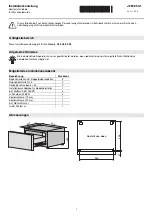
DB-200-6
49
5
Commissioning
The pressure equipment was tested in the factory as a
single part. After installation, the tightness of the con-
nections and of the pipe works must be tested.
5.1
Testing tightness of refrigerant side
▶ Test the refrigerant circuit (assembly) for tightness,
as a whole or in parts, according to EN378-2 or other
applicable equivalent safety standards.
▶ For this, create an overpressure, preferably using
dried nitrogen.
DANGER
Risk of bursting due to excessive pressure!
The pressure applied during the test must never
exceed the maximum permitted values!
Test pressure: 1.1-fold of the maximum allow-
able pressure, see name plate.
5.2
Charging refrigerant
DANGER
Risk of bursting of components and pipes due to
excess hydraulic pressure.
Vessel and pipes may burst, small components
may shoot out. The pressure wave may be
lethal.
Never charge blocked components and pipes
completely with liquid or leave them charged.
Leave sufficient volume above the liquids.
▶ Use only permitted refrigerants, see chapter Applica-
▶ If coolant is already charged: Commission the
coolant circuit before charging with refrigerant. Oth-
erwise the coolant might freeze.
!
!
NOTICE
Risk of wet operation by charging liquid refriger-
ant!
Measure out extremely precise quantities!
Keep the oil temperature above 40°C.
▶ Charge the condenser or receiver directly with liquid
refrigerant; in systems with flooded evaporator, pos-
sibly also the evaporator.
▶ Blends must be taken out of the charging cylinder as
a bubble-free liquid.
▶ After commissioning, it may be necessary to add re-
frigerant: While the compressor is running, charge
with refrigerant on the suction side, preferably at the
evaporator inlet.
5.3
Charging coolant
▶ Charge only permitted coolants, see chapter Applic-
▶ Use only well mixed coolant. Make sure that the ad-
ditives are homogeneously distributed in the coolant
before using it.
▶ Overcharging must be avoided!
DANGER
Risk of bursting of components and pipes due to
liquid overpressure.
Serious injuries are possible.
Make sure not to exceed maximum admissible
pressures!
▶ Mind the heat expansion of the coolant!
▶ Completely purge the coolant circuit.
▶ Perform a pressure check, see below.
▶ Carefully adjust the flow regulating valve.
▶ Check and adjust the calculated flow velocities in the
whole pipe works for all load conditions.
▶ If the system is not operated immediately afterwards:
Protect the coolant side against corrosion, see
chapter Standstill, page 50.
5.3.1
Testing tightness of coolant side
▶ Test using dry gas or clean water.
▶ Do not exceed the maximum operating pressure at
any time during the test.
▶ Test the whole pipe works for leaks.
▶ If the water was not clean, clean the pipe works after
the test.
▶ Dry the pipe works.
















































